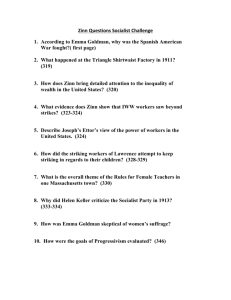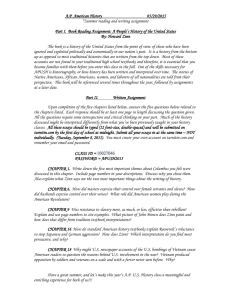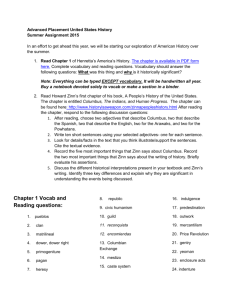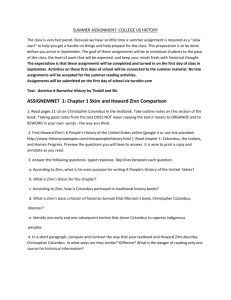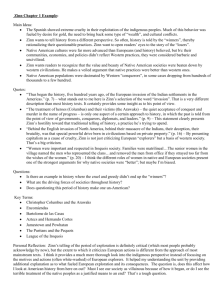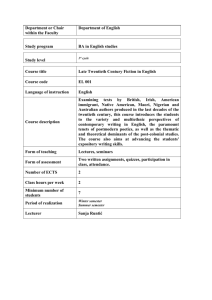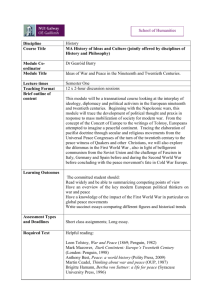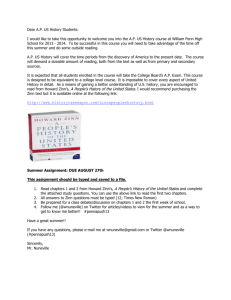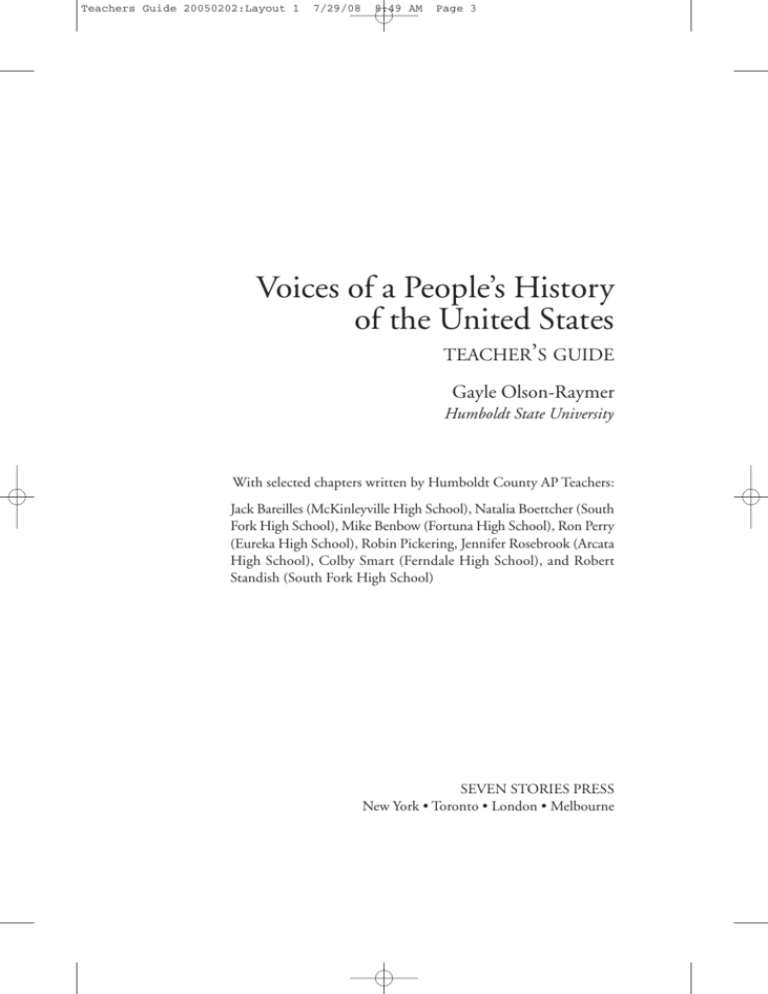
Teachers Guide 20050202:Layout 1
7/29/08
8:49 AM
Page 3
Voices of a People’s History
of the United States
TEACHER’S GUIDE
Gayle Olson-Raymer
Humboldt State University
With selected chapters written by Humboldt County AP Teachers:
Jack Bareilles (McKinleyville High School), Natalia Boettcher (South
Fork High School), Mike Benbow (Fortuna High School), Ron Perry
(Eureka High School), Robin Pickering, Jennifer Rosebrook (Arcata
High School), Colby Smart (Ferndale High School), and Robert
Standish (South Fork High School)
SEVEN STORIES PRESS
New York • Toronto • London • Melbourne
Teachers Guide 20050202:Layout 1
7/29/08
8:49 AM
Page 4
Copyright © by Gayle Olson-Raymer
All rights reserved. No part of this book may be reproduced, stored in a retrieval
system, or transmitted in any form, by any means, including mechanical, digital,
photocopying, recording, or otherwise, without the prior written permission of the
publisher.
Seven Stories Press
Watts Street
New York, NY
www.sevenstories.com
ISBN-:
--- / ISBN-: ----
College professors may order examination copies of all Seven Stories Press titles for
a free six-month trial period. To order, visit www.sevenstories.com/textbook, or fax
on school letterhead to --.
College professors who have adopted Voices of a People’s History of the United States
by Howard Zinn and Anthony Arnove as a course textbook are authorized to
duplicate portions of this guide for their students.
Design by Jon Gilbert
Printed in the U.S.A.
Teachers Guide 20050202:Layout 1
7/29/08
8:50 AM
Page 157
CHAPTER THIRTEEN
Socialists and Wobblies
Today’s generation of young adults have a difficult time imagining the early twentieth century. Indeed, it is hard to imagine a time when there were , registered Socialists, , of whom held elected offices; when there were , labor
strikes in a single year; when an avowed Socialist ran for president and received
, votes; when women put their lives on the line for the right to vote. These
were heady times, full of spirited resistance to a system that had ignored working
Americans for far too long.
Almost a hundred years later, the actions and deeds of those who dared to question the establishment are vivid reminders of our power as ordinary Americans. It
is an important message—the power of our dissenting voices and of our commitment to a more egalitarian society for our students to hear.
Document-Based Questions
MOTHER JONES
.
What is a “motley gathering”? Do you think Mother Jones would have
described her audience in the same manner as did the reporter?
. Do you think this speech aroused the audience from its “lethargy”? How
and why? Might it have moved you to action if you had been a worker in
the audience? Explain.
. Why do you think that, although she “violated injunction after injunction,” Mother Jones was not re-arrested? What made Mother Jones an especially dangerous radical in the eyes of the corporate owners?
UPTON SINCLAIR
.
Do you agree with Sinclair’s “two carefully worded propositions,” describ-
~ ~
Teachers Guide 20050202:Layout 1
7/29/08
8:50 AM
Page 158
~
ing what a Socialist believes? Do you think he has appropriately described
what an anarchist believes? How might you change his descriptions?
. Why do you think Dr. Schliemann’s “formula of modern proletariat
thought” did not attract enough of the American proletariat to enact the
restructuring of the country’s political, social, and economic structure at the
turn of the century?
. How would you answer the question Sinclair posed, “Do you think that it
would be too much to say that two hours of the working time of every efficient member of a community goes to feed the red fiend of war”? Could
this same formula be applied in the early twenty-first century?
W.E.B. DU BOIS
.
What is the “peculiar sensation, this double-consciousness” that W. E. B.
Du Bois describes? How and why do African Americans in today’s world
continue to cope with this sensation?
. How did Du Bois describe the African Americans’ “vain search for freedom”? How did this search contribute to the “new vision” that replaced
the “dream of political power”? What was the vision?
. What are Du Bois’s dreams for a better future? Which do you believe were
accomplished in his lifetime? Which remain to be accomplished?
EMMA GOLDMAN
.
How does Emma Goldman describe patriotism? Do you think most
Americans would similarly describe patriotism in the early twenty-first
century?
. Do you think Goldman makes a convincing argument for her belief that
patriotism is a “menace to liberty”? What are her strongest and weakest
points?
. Goldman repeatedly mentions the growth of solidarity in her address.
What evidence do you find in her address, as well as within the other voices
in this chapter, of such solidarity?
Teachers Guide 20050202:Layout 1
7/29/08
8:50 AM
Page 159
~
“PROCLAMATION OF THE STRIKING TEXTILE WORKERS”
.
Why do you think this proclamation resonated with workers from around
the world? Do you think it might have had greater support from abroad than
from within the United States? How and why?
. The proclamation is deliberately modeled on the language and format of
the Declaration of Independence. Do you think this structure and style is
effective? Do you think the two tyrannies—the tyranny of the Crown and
the tyranny of the mill owners—are comparable? How and why?
. Why do you think the city government and local police upheld the rights
of the mill owners rather than the strikers?
ARTURO GIOVANITTI
.
What is the “ethical side” of striking that Arturo Giovanitti describes? Do
you think these are just the words of “dreamers” or “fanatics”—a question
he poses to the District Attorney?
. President Abraham Lincoln stated that the Union could not exist “half free
and half slave.” Why does Giovanitti—who wrote fifty years later—feel
that America was still “half free and half slave”?
. Why do you think the jury acquitted Giovanitti?
WOODY GUTHRIE
.
To whom is this song addressed? Who is the “you” who “would kill our
children,” and whose “soldiers” were waiting while the miners slept?
. Guthrie mentions “wire fence corners” twice. What is he describing? Why
is this important to understanding the song—or is it?
JULIA MAY COURTNEY
.
Julia May Courtney predicted that, “every workingman in Colorado and
in America will not forget” the cry, “Remember Ludlow.” Is this true? If not,
why?
. Do you think the statement, “[F]or the first time in the history of the labor
Teachers Guide 20050202:Layout 1
7/29/08
8:50 AM
Page 160
~
war in America the people are with the strikers” was correct? Do you think
the people did support them? Why, or why not? Why would they support
these strikers and not others?
. Do you think there is another side to the Ludlow Massacre, other than that
presented by Courtney and Guthrie? How would that side justify its actions?
JOE HILL
.
Why do you think Joe Hill cabled Haywood from his jail cell and told him,
“Don’t waste time mourning. Organize!”? Do you think Haywood and
other organizers honored Hill’s request?
. Why do you think Joe Hill remains a hero for those involved in the contemporary struggles related to labor?
. What “fading flower” do you think Joe Hill would wish to see “come to life
and bloom again”?
Main Points in Voices, Chapter 13, “Socialists and Wobblies”
After reading Chapter in Voices, students should be encouraged to identify what
they believe to be the main points therein. Following are five possible main points.
.
Early twentieth-century radicalism in the United States was fueled by overseas wars, miserable working conditions, the growing gap between the rich
and the poor, and unremitting poverty.
. Socialism reached the height of its popularity in America during the early
twentieth century.
. Despite almost three hundred years of victimization, many African
Americans approached the turn of the twentieth century with dreams for
a better future.
. To some workers in the United States labor movement, true freedom for
the working-class depended on the abolition of “wage slavery.”
. Union membership and activity grew at an unprecedented rate during the
early twentieth century.
Teachers Guide 20050202:Layout 1
7/29/08
8:50 AM
Page 161
~
Main Points in Voices, Chapter 13, “Socialists and Wobblies,”
and in A People’s History, Chapter 13,
“The Socialist Challenge”
If your students are also reading A People’s History, they should be encouraged to
identify what they believe to be the main points in Chapter in both books.
Following are five additional points to be stressed when Voices and A People’s History
are used together.
. War and imperialistic impulses postponed, but did not suppress, the class
conflict brewing in America at the turn of the century.
. While the Wobblies (the IWW) never had a huge membership at any given
time, their energy, commitment, inspiration to others, and ability to mobilize made them far more influential in the country than their numbers
might suggest.
. Progressive Era reforms were intended to “stabilize the capitalist system by
repairing its worse defects, blunt the edge of the Socialist movement, and
restore some measure of class peace” (People’s History, p. ).
. During this period, socialism moved out of the small circles of city immigrants and “became American.”
. Women of the early twentieth century were members of a pioneering generation who set the agenda for social reform for the next several decades.
General-Discussion Questions for Voices
While the following questions are designed for classroom discussion about all the
voices read in Chapter , they can also be rewritten and included as evaluation
tools.
.
How is the “wage slavery” described by Mother Jones similar to that
described by many of the voices in Chapter ?
. Were conditions better or worse for the working poor in the early twentieth century than they had been in the Gilded Age?
Teachers Guide 20050202:Layout 1
7/29/08
8:50 AM
Page 162
~
. Who were the United Mine Workers? How strong was their union in West
Virginia? What specific labor battles did they fight?
. Why do you think some people were willing to become strike breakers?
. How is corporate hiring of strike breakers yet another example of the
divide-and-conquer strategy used by those in power?
. How do you think the white reading public reacted to the publication of
The Souls of Black Folk?
. Why are many of the authors in this chapter so disdainful of “reformers”?
. Do you think it is more possible today for “a man to be both a Negro and
an American” then it was at the turn of the twentieth century?
. How do you think the authors of these entries would describe a truly free
society?
. Do textile workers, or any other organized groups of workers, ever “rise
in armed revolt against their oppressors” as the mill workers in Lawrence
predicted?
. Do you think striking is justified? If so, under what conditions? If not, why
not? Should doctors, police, or fire fighters be allowed to strike? Why, or
why not?
. How do you think federal, state, and local governments justified their
responses to strikes?
General-Discussion Questions for Voices and A People’s History
These general-discussion questions are additional questions for students who have
read Chapter in both books. For all questions, discussion must focus on ways
the materials in both chapters help students formulate and articulate their
answers.
. Emma Goldman wrote about the Spanish-American War that, “the lives,
blood, and money of the American people were used to protect the interests of the American capitalists.” How do the voices in chapters and
echo her sentiments?
Teachers Guide 20050202:Layout 1
7/29/08
8:50 AM
Page 163
~
. What do you think attracted people like Jack London, Upton Sinclair, and
Helen Keller to socialism?
. Who were the “muckrakers” of the early twentieth century? Who are the
muckrakers of the twenty-first century?
. What led to the panic and financial collapse of ? How did the crisis contribute to the social, political, and economic unrest of the early twentieth
century?
. Why do you think that a memorial parade in which , people
marched was held for the victims of the Triangle Shirtwaist Factory, while
there was little media coverage and far less interest in the victims of the
Ludlow Massacre, which occurred two years later?
. How do you feel about the fact that in the early twenty-first century, fortyfour families made $ million a year—a sum equal to the total income of
, families who each made $ a year?
. Why were African Americans kept out of the trade-union movement for so
long? How might their membership have strengthened the unions?
. What made the IWW different from other unions?
. What does Howard Zinn mean when he writes that “there was almost a religious fervor” (People’s History, p. ) to the Socialist movement?
. What role did African Americans play in the founding and leadership
of the National Association for the Advancement of Colored People?
What were the early goals of the naacp, and who were some of its early
leaders?
. What is a trust buster? According to Howard Zinn, was Theodore Roosevelt
really a trust buster?
Evaluation Tools
SUGGESTED ASSIGNMENTS
These assignments can be adapted to meet any classroom need—homework,
short- or long-term research projects, individual or group work. The end prod-
Teachers Guide 20050202:Layout 1
7/29/08
8:50 AM
Page 164
~
uct should be flexible, depending on teacher interest and student abilities—
papers, journals, oral reports, visual aides, and the like.
.
Find out more about the United Mine Workers. What were the goals and
activities of their union in West Virginia? What specific labor battles did
they fight? What were their accomplishments? How are the labor grievances of miners different from and the same as the labor grievances of other
workers throughout the United States in the early twentieth century?
Compare and contrast the labor conditions of these miners with those of
the twenty-first century.
. Read The Communist Manifesto by Karl Marx and Friederich Engels.
What are their specific grievances against capitalism and capitalists? How
do they propose that socialism will cure these evils? Does this more indepth discussion of socialism help you to better understand why it was
so attractive to many workers in the early twentieth century? How and
why?
. Read The Jungle by Upton Sinclair. Why do you think this classic novel is a
century old but still resonates with many American readers? What do you
believe to be the three primary themes that Sinclair wants you to understand about Jurgis’s story? Do you agree or disagree with them? Explain.
When you are finished, read “The Chain Never Stops” by Eric Schlosser, published in Mother Jones magazine. (See http://www.motherjones.com/
news/feature///meatpacking.html) How does this article about workers in the meatpacking industry at the end of the twentieth century compare
and contrast with the experiences faced by Jurgis and his family almost a hundred years earlier?
. Go to the website for Mother Jones magazine at http://www.mojones.com/.
Read the most recent issue and then determine why the journal is named
after Mother Jones. What is your overall impression of the articles? Who
do you think would subscribe to this journal? Would you subscribe? Why,
or why not?
. Learn as much as possible about the Ludlow Massacre. What were the initial grievances of the workers at Ludlow? Locate several newspaper articles
that reported the event. Were they supportive of the strikers, strikebreakers, and/or the federal government’s response? How and why? Do you think
Teachers Guide 20050202:Layout 1
7/29/08
8:50 AM
Page 165
~
Woodie Guthrie’s lyrics accurately portrayed the event? Why do you think
it was thirty-three years before the Ludlow Massacre was memorialized by
Guthrie’s song? Why would he write this song in ?
. Find a recording of “Ludlow Massacre.” Then locate recordings and lyrics
of other songs written between the late s and the s about union
organization that occurred during the early twentieth century. What do
they have in common? Which do you think most accurately portrayed the
events? How successful were these recordings? Why do you think folk
singers and writers of the mid-twentieth century were attracted to this
early-twentieth century movement?
. Find out more about the labor organizer Joe Hill. What was his background, and how did it influence his decision to join the IWW? Locate some
of his songs. Read the lyrics and listen to any recordings. How do his songs
reflect his experiences as a labor organizer? What was the nature of the
crime for which he was indicted and found guilty? Learn as much about the
trial as possible. Do you think he received a fair trial? Do you think Hill
became a martyr to the labor movement? How and why?
. In , Alfred Hayes wrote the lyrics for what later became the famous
song—set to music by Earl Robinson—“Joe Hill.” Over the next several
decades, Paul Robeson performed, popularized, and recorded this song
repeatedly. In the s, such well-known folk performers as Pete Seeger and
Joan Baez further popularized the song. Read the lyrics for all six verses, then
listen to several different renditions of the song. Which do you think is
most powerful and why? Do you think Hayes’ purpose in writing the song
was to make a labor-union hero out of Hill? Did the song accomplish this?
Explain. Do you think this song would resonate with American workers in
the early twenty-first century? Explain.
. Pick one of the early twentieth-century muckrakers for a biographical
sketch. Ida Tarbell, Lincoln Steffens, Jacob Riis, Upton Sinclair are all possibilities. Learn more about their backgrounds and what led them to print
what they witnessed. How did their muckraking efforts lead to reform?
What opposition did they face?
. Howard Zinn describes the existence of sweatshops at the turn of the century. Learn as much as possible about sweatshops in one urban area between
and . How did they operate? Who was involved with sweatshop
Teachers Guide 20050202:Layout 1
7/29/08
8:50 AM
Page 166
~
labor? Were sweatshop workers involved in unions? Who benefited from
sweatshop labor? What were working conditions like for sweatshop laborers? Then learn about contemporary sweatshops that operate in American
today. Compare and contrast sweatshop conditions in the United States at
the turn of the twentieth century with conditions at the turn of the twentyfirst century.
. Learn more about the Wobblies—the IWW. How did it arise and gain
momentum in the United States? What were its goals and accomplishments? Where, regionally were its efforts most or least successful? Explain.
To whom did the Wobblies appeal?
. Find out more about Emma Goldman. How did her background contribute to her decision to become a political activist devoted to overthrowing capitalism? Why did the government consider her to be a dangerous
woman? Do you think she was dangerous? Explain. Would the government today think she was dangerous? How and why?
SUGGESTED ESSAY QUESTIONS
.
In Mother Jones’ speech, she states that “a contented workman is no good.”
Using examples from your reading, explain how this statement illustrates
the ongoing struggle between corporation owners and labor.
. Provide examples from the reading to support Du Bois’ statement that “the
problem of the Twentieth century is the problem of the color line.” Has the
problem been solved in the twenty-first century? Explain.
. Many of the voices in this chapter discuss their quest for freedom. How are
their concepts of freedom similar? Which have more realistic expectations
for achieving freedom? Which have more unrealistic expectations? Explain.
How do their definitions of freedom compare and contrast with your own?
. In her speech, Emma Goldman predicted that as America became the
“most powerful nation on earth,” it would “eventually plant her iron foot
on the necks of all other nations.” What did she mean? Using examples
from the reading, explain how her prediction did or did not come true.
. The striking mill workers in Lawrence wrote in that “as useful members of society and as wealth producers we have the right to lead decent
Teachers Guide 20050202:Layout 1
7/29/08
8:50 AM
Page 167
~
and honorable lives.” How and why would others whom you have read
about during this period have supported this statement? How do you think
they would describe such a “decent and honorable” life? Do you think that
everyone has such a right? Why, or why not? What role, if any, should the
government play in helping people to lead such a life?
. Almost a hundred years ago, Margaret Sanger wrote, “No woman can call
herself free who does not own and control her own body.” How do you suppose this sentiment was accepted at the turn of the century? How is this very
same sentiment used in the twenty-first-century context?
. Howard Zinn argues that the Progressive period did not usher in real reform
because “fundamental conditions did not change . . . for the vast majority
of tenant farmers, factory workers, slum dwellers, miners, farm laborers,
working men and women, black and white” (People’s History, p. –).
Support or refute this statement with ample examples from your reading.
. Using examples from the reading, how and why were African Americans
excluded from involvement in the socialist and union movements in the early
twentieth century? How were they included?
. Using examples from the readings, explain how and why Socialism was so
attractive to some workers in the early twentieth century. Why do you think
Socialism failed to attract a larger following among the working and middle classes? Why do you think that almost a hundred years later, Socialism
and Socialists have less influence than they had at this time?
. Many of the people whose voices you have read in this/these chapter(s) were
considered dangerous to the public good in the early twentieth century.
Which do you think were believed to be most dangerous, and why? Do you
think they posed a real danger to the nation? Do you think the real or perceived danger they posed justified placing any limits on civil liberties?
SIMULATIONS AND OTHER CREATIVE APPROACHES
.
Write a one-person play about a union organizer, antiwar activist, or feminist who was involved in a social movement at the turn of the century.
Some of your dialog should originate with the actual speeches and essays
of the activist. Perform this play for an audience of your choice.
Teachers Guide 20050202:Layout 1
7/29/08
8:50 AM
Page 168
~
. Imagine you are a contemporary muckraker who has been hired to write
an article for the next issue of Mother Jones—a magazine founded in
as an independent, nonprofit publication committed to social justice. Select
a contemporary labor issue to investigate and be sure your research includes
a comparison with labor conditions that existed at the turn of the twentieth century. Then write your article. To learn more about Mother Jones,
refer to its online journal at http://www.mojones.com/index.html.
. Conduct a survey among young adults in which you will ask two questions: How would you define patriotism? What thoughts or actions would
you consider unpatriotic? Make a list of all the characteristics the answers
have in common and another list for singular characteristics. Using these
various definitions, create the following: your own definition of patriotism in the twenty-first century and a list of actions considered to be unpatriotic in contemporary society. Then write a short children’s book in which
you compare and contrast these definitions and perceptions of patriotism
in the early twenty-first century with ideas about patriotism in the early twentieth century.
. Write a poem or compose a song that memorializes one of the persons
involved in or events that were part of the resistance movements at the turn
of the twentieth century.
. Stage a town meeting as you imagine it would have been held in an industrial town in the early twentieth century. Invite at least three persons whom
you learned about in your reading. Each will give a – minute speech
about his or her commitment to and involvement in Socialism and the
beliefs about how Socialism can help United States workers. Invite three
other persons from corporate management who will refute their claims.
Community members (the remaining students in the class) will ask questions of the speakers.
OTHER HOWARD ZINN TITLES AVAILABLE FROM
SEVEN STORIES PRESS
For ordering and course adoption information visit
www.sevenstories.com and www.sevenstories.com/textbook
A Young People’s History of the
United States
Adapted by Rebecca Stefoff
Zinn’s first book for young adults retells U.S.
history from the viewpoints of slaves, workers,
immigrants, women, and Native Americans,
reminding younger readers that America’s true greatness is shaped by our dissident voices, not
our military generals. The single-volume edition also includes side-bar stories of actual children
who made American history, from Anyokah, who helped bring written language to her
Cherokee people, to John Tinker, a high school student who fought all the way to the Supreme
Court for freedom of expression at school—and won.
“In many years of searching, we have not found one history book to recommend . . . until the just
published A Young People’s History of the United States. This is the edition of A People’s History that
we have all been waiting for.”—Deborah Menkart, executive director, Teaching for Change
Volume 1: From Columbus to the Spanish-American War / Paper over board 978-1-58322-759-6 $17.95 224 pages, illustrations throughout
Volume 2: From Class Struggle to the War on Terror / Paper over board 978-1-58322-760-2 $17.95 240 pages, illustrations throughout
-
Paper 978-1-58322-869-2 $19.95 464 pages, 50 b&w, illustrations and photos
Cloth 978-1-58322-886-9 $45.00 464 pages, 50 b&w, illustrations and photos
Voices of a People’s History of the United States
Second Edition
Edited with Anthony Arnove
The companion volume to historian Howard Zinn’s legendary best-selling book
A People’s History of the United States.
“Voices should be on every bookshelf. [It presents] the rich tradition of
struggle in the United States, from the resistance to the conquest of the
Americas in the era of Columbus through the protests today of soldiers and
their families against the brutal invasion and occupation of Iraq.” —Arundhati Roy
“In Voices, Howard Zinn has given us our true story, the ongoing, not-so-secret narrative of race
and class in America.” —Russell Banks
Paper 978-1-58322-628-5 $22.95 672 pages
Readings from Voices of a People’s History
of the United States
Edited by Anthony Arnove and Howard Zinn
Authors Howard Zinn and Anthony Arnove are joined on this audio
CD by Danny Glover, Sarah Jones, Paul Robeson, Jr., Lili Taylor,
Wallace Shawn, and Marisa Tomei to perform rousing words of dissent
selected from the complete anthology.
Audio CD 978-1-58322-752-7 $14.95 45 minutes
Artists in Times of War
Zinn’s essays discuss America’s rich cultural counternarratives to war, from
grassroots pamphlets to the likes of Bob Dylan, Mark Twain,
E. E. Cummings, Thomas Paine, Joseph Heller, and Emma Goldman.
“The essays are all elegantly written and relate history to the great crisis of
current times: war of aggression, western state terrorism, and obedience to
state power under the guise of patriotism.” —Tanweer Akram, Press Action
Open Media Book / Paper 978-1-58322-602-5 $9.95 160 pages
Howard Zinn on History and
Howard Zinn on War
These two companion volumes are handy pocket guides on
the power of history when it is put to the service of the
struggle for human rights, and on the meaning of war in a
world where we have so far proven unable to overcome our
primitive predilection for destroying our neighbor.
On History Paper 978-1-58322-048-1 $12.95 240 pages / On War Paper 978-1-58322-049-8 $12.95 224 pages
Terrorism and War
Edited by Anthony Arnove
Zinn explores how truth, civil liberties, and human rights become the first
casualties of war and examines the long tradition of Americans’ resistance
to US militarism.
“A significant number [of students] say that this and other books from a
radical perspective have transformed their understanding of US society,
politics, and culture.” —Darrell Y. Hamamoto, University of California, Davis
Open Media Book / Paper 978-1-58322-493-9 $9.95 144 pages
The Zinn Reader
Writings on Disobedience and Democracy, 2nd Edition
The definitive collection of Zinn’s writings on the great subjects of our time—
race, class, war, law, means and ends—now updated with thirteen recent
essays.
“A welcome collection of essays and occasional pieces by the dean of radical
American historians.”—Kirkus Reviews
Paper 978-1-58322-870-8 $21.95 752 pages
La otra historia de los Estados Unidos
“Zinn’s work is a classic of revisionist history, bringing forth voices that have
previously been muffled. He lets women, African Americans, workingclass
people, and, yes, Hispanics speak for themselves. This Spanish edition should
prove popular in both public and academic libraries.”
—Library Journal
The first Spanish-language edition of Howard Zinn’s contemporary classic, A People’s History of
the United States.
SIETE CUENTOS EDITORIAL
Paper ISBN 978-1-58322-054-2 $19.95 504 pages
THE ZINN EDUCATION PROJECT
Seven Stories is pleased to support the Zinn Education Project, a collaboration between
Rethinking Schools and Teaching for Change, dedicated to introducing middle school and high
school students to a more accurate, complex, and engaging understanding of United States
history than is found in traditional textbooks and curricula. Visit the web site to see how you
can bring Zinn’s teaching into the classroom, showing students that history is made not by a
few heroic individuals, but by people’s choices and actions. http://www.zinnedproject.org
A People’s History for the Classroom
Bill Bigelow
Activities and projects for middle school and high school classrooms, inspired by Zinn’s A People’s
History. Available from The Zinn Education Project: http://www.zinnedproject.org

